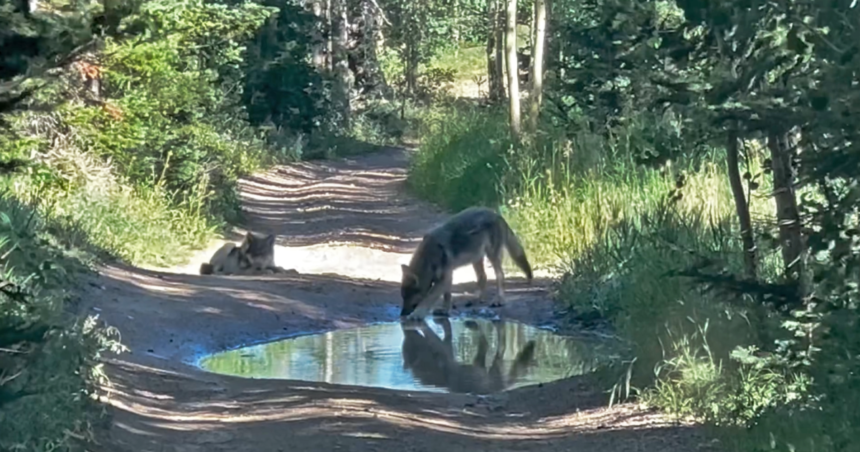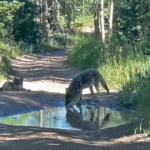Colorado Parks and Wildlife has initiated an operation to capture and relocate the wolves from the Copper Creek Pack, which have been responsible for multiple depredations — instances of preying on livestock — since wolves were reintroduced in the state in December.
CPW announced Tuesday evening that this process is currently underway, with technical support from federal partners. Director Jeff Davis emphasized that the decision was made after careful consideration and feedback from various stakeholders.
“Our options in this unique case were very limited, and this action does not set a precedent for how CPW will handle wolf-livestock conflicts in the future,” Davis stated. “The main objective of the operation is to relocate the pack to a new location while exploring the best options for them to continue contributing to the successful restoration of wolves in Colorado.”
RELATED STORY | Colorado hunts for co-existence between people and wolves
The Copper Creek Pack, named in June, consists of at least one breeding pair and three pups. A wolf pack is officially established once a pair reproduces, and this was confirmed on June 18 when CPW biologists spotted a single wolf pup at a den site in Grand County. The Copper Creek Pack is Colorado’s first confirmed wolf pack since the reintroduction in December.
A video capturing the wolf pups was recently shared publicly for the first time, with state officials confirming that all the young animals appeared to be in good health.
WATCH: 3 healthy wolf pups spotted in Colorado
Specific details regarding when and how CPW plans to capture the wolf pack, as well as their intended relocation destination, are currently unclear. In response to follow-up inquiries from Scripps News Denver, CPW mentioned that more information will be provided at a later time.
A section of the federal Endangered Species Act related to this wolf reintroduction grants Colorado officials the authority to relocate the wolves. This decision allowed the state wildlife organization to enhance its management capabilities for the animal, including strategies like aversive conditioning and lethal take for protection of people and livestock, especially post-reintroduction.
“Management of the nonessential experimental population would enable gray wolves in the NEP (nonessential experimental population) to be hazed, killed, or relocated by the Service or our designated agent(s) for livestock depredations,” the document mentions.
RELATED STORY | Yellowstone National Park’s oldest wolf gave birth to 3 pups this spring
For the protection of these animals, CPW is not disclosing the exact location of the Copper Creek Pack. However, during a recent CPW Commission meeting, CPW Assistant Director Reid DeWalt mentioned that the primary issue of depredation persists with the breeding pair in Middle Park.
“We are continuing to address this situation for potential solutions and opportunities for improvement,” he stated. “While there have been depredations by a few other wolves, they have not reached the same level as those in Middle Park.”
To gain deeper insights into wolf depredations, CPW has employed five predator damage conflict specialists who will focus on wolves, as well as black bears and mountain lions.
Throughout the planning and execution of the wolf reintroduction project, CPW has collaborated with wildlife biologists, federal partners, and livestock producers, a collaboration that will continue throughout the process.
As of Tuesday evening, 24 animals — sheep, calves, and cows — have been injured or killed by wolves since the December 2023 release. These incidents occurred in Jackson County, Grand County, and Routt County, with the most recent incident involving eight sheep in Grand County on July 28.
RELATED STORY | US House votes to remove wolves from endangered list in 48 states
Currently, Colorado is home to 11 known adult wolves — nine introduced in December (originally 10, but one was killed by a mountain lion in April) and two that had previously migrated to Colorado — along with three pups.
The wolf reintroduction was mandated by voters in 2020. In May 2023, the Colorado Wolf Restoration and Management Plan was finalized after years of consultations and discussions with local communities. By the end of the year, 10 wolves had been released in Grand and Summit counties.
Subsequently, these wolves have spread to different watersheds in the state, as shown in the latest gray wolf activity map below. This map is updated on the fourth Wednesday of every month here. As of the map’s publication, the wolves had not moved south of Interstate 70.
Colorado Parks and Wildlife
The next phase of wolf reintroduction is scheduled to begin this winter in the northern zone, as outlined in the Colorado Wolf Restoration and Management Plan.
Shown in the map below, this area represents the upper oval:

Colorado Parks and Wildlife
In July, a rancher in the Middle Park region, who had experienced multiple confirmed wolf depredations, requested a lethal take permit from CPW due to chronic depredation, seeking permission to eliminate a wolf that had frequently harmed or killed their livestock.
CPW had documented wolf-related injuries or deaths involving three yearling cattle on April 17, one yearling cattle on April 18, one yearling cattle on April 28, one yearling cattle on May 11, and one sheep on July 17.
The rancher’s request for a lethal take permit was denied by CPW, as evidenced in a letter obtained by Defenders of Wildlife and shared with Scripps News Denver.
In the letter to the rancher, CPW explained the four criteria required to issue such a permit, highlighting that only one criterion was met:
- Documented repeated depredation and harassment of the applicant’s livestock or working dogs caused by the wolf, wolves, or targeted pack (meets criteria)
- Implementation of various nonlethal conflict minimization methods and materials (does not meet criteria)
- Predicted continuation of additional wolf-related depredation with or without lethal control (does not meet criteria)
- Unintentional or intentional use of attractants potentially luring or baiting wolves to the site (does not meet criteria)
CPW elucidated the denial reasoning in their response letter, indicating that the ranch:
- Tried some nonlethal methods before considering lethal control, but “delayed the use or refused to utilize other available nonlethal techniques that could have prevented or minimized depredations.”
- Had the opportunity to hire a range rider on April 5 but declined it until April 29. The Colorado Department of Agriculture had offered funding for this nonlethal deterrent in early April. Upon the arrival of the range rider, depredations decreased to two within 12 weeks.
- Opted against using specific nonlethal measures like fladry or pursuing a nonlethal injurious hazing permit. These were considered after requesting lethal control. The ranch eventually agreed to explore these options, but CPW emphasized the lack of timely implementation of available nonlethal conflict minimization measures. Failure to utilize these tactics could have prevented some or all of the depredations, hence weighing against lethal control.
- Failed to bury a dead pit used for disposing of deceased ranch animals. An open pit was likely attracting wolves to the property; CPW suggested that once the pit was buried on May 8, depredations decreased in the following 10 weeks.
The letter concluded with CPW expressing their gratitude to the rancher for their cooperation. Public engagement is encouraged to report wolf sightings, especially with accompanying photos or videos. To submit a sighting, visit CPW.info/wolf-sighting.
For the full wolf restoration and management plan, see below or click here.
This article was originally written by Stephanie Butzer for Scripps News Denver.





